n.b. —
These notes on scanned signal codes were previously included on a larger telegraphic codes page. Currently in the works is a more detailed discussion of John Macdonald his A Treatise Explanatory... in which a Comprehensive Numerical Dictionary... is applied (1817).
| 1763 | Tactique navale, ou, Traité des Évolutions et des signaux; avec figures en taille-douce. | naval | Paris |
Bigot de Morogues, Sebastien François (1705-1781).
Paris, H.L. Guerin & L.F. Delatour, 1763
original at Michigan.
in two parts :
Livre Premieur — Des Évolutions. (13 chapitres).
Livre Second — Des Signaux et Ordres Généraux.
Tactique Navale is primarily devoted to tactics, but integrates signals with its presentation, so important are they to the success of naval evolutions
involving multiple vessels.
| 1803 | Telegraphic Signals; or Marine Vocabulary. | naval, military | Whitehall |
By Sir Home Popham.
Printed for T. Egerton, Military Library, Near Whitehall. 1803
original at NYPL, which copy contains annotations/additions throughout, though only scarcely visible in this scan.
This is an expansion of a Popham’s earlier (1800) code, which is now incorporated in a first section. To that are added two sections: (1) words next useful to those in the first,
which are placed opposite to it in alphabetical order, to save the trouble of opening the book twice,
and (2) a third separate part (beginning at page 63), consisting of sentences most applicable to military or general conversation. These sentences should be frequently practised to make them familiar, as they will save many signals.
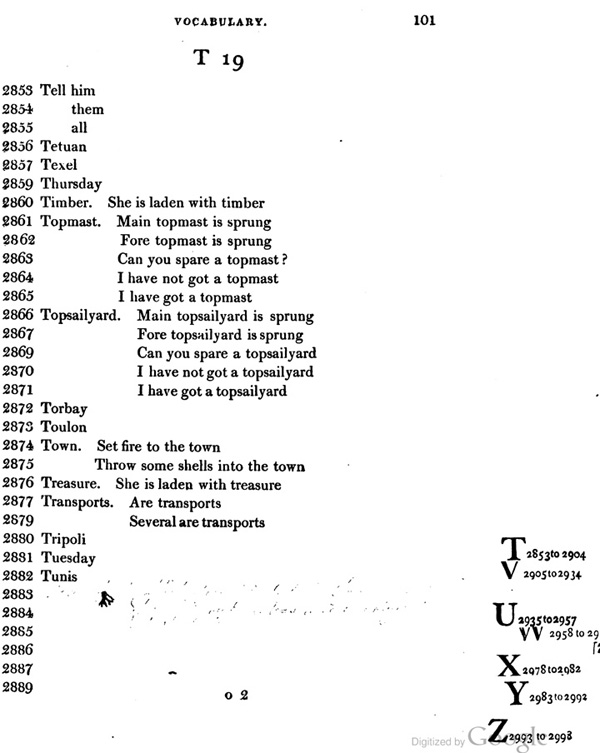
Faint annotations throughout, flag-numbered tabs.
| 1808 | John Macdonald. A Treatise on Telegraphic Communication, Naval, Military, and Political. | naval, military | Paris |
A Treatise on Telegraphic Communication, Naval, Military, and Political....in which the known defects of the present system of telegraphic practice by sea and land are obviated by the introduction of a Numerical Portable Dictionary, Calculated, when applied to various described Telegraphs, and to the Naval Flag System, to be an accurate Medium of carrying on distant Conversation, without any Liability to Confusion, Error, or Mistake: with some considerations on the present state of the marine code, and of naval signals. Illustrated by linear plates Connected with the Detail of The New Telegraphic System; Substituting, on very simple Principles, a speaking, in lieu of a spelling power, in Different Day and Night Maritime, Civil and Military Telegraphs.
By John Macdonald. Printed for T. Egerton, Military Library, Near Whitehall. 1808
The title page includes this epigram —
frustra fit per plura, quod fieri potest per pauciora
evidently from Aristotle (and associated with Occam’s Razor), that Englished signifies It is vain to do with more, what can be done with less.
This volume includes a specimen of the Telegraphic Dictionary
, pp67-77, covering 999 terms, and of a second vocabulary consisting of expressions, not found in the former dictionary, now arranged in classes
each able to total 999 words. The 1817 code expands this second vocabulary.
original at Michigan.
| 1808 | Joseph Conolly. A Treatise on Telegraphic Communication by Day and Night. | naval, military | London |
A Treatise on Telegraphic Communication by Day and Night,for Naval, Military, and Commercial Purposes. (on new principles.) Illustrated with engravings and coloured flags; By which are exemplified the different Methods of working by regular and compound Numbers. Also is added A Numerical Inflected Dictionary of The English Language, Calculated for Communication on any Subject, and adapted to any Numerical Code.
By Joseph Conolly. London: Printed and Published by W. Winchester and Son, Strand. 1808
original at Michigan HE9737 .C75
Title; Advertisement (2pp); Numerical Flag Table (Plate 15); Naval Code. Of flags and pendants
pp 5-6; Of regular number pp 6-7; Of compound numbers pp 7-10 (includes a Table of Compound Numbers (Plate 16), examples of compound numbers (Plate 3); Table of numbers from 1 to 999 (with reference to compound numbers in rotation as they occur) pp 11-16; On the use of pendants, pp 17-18; On alphabetical signals p18; On hoisting and lowering signals pp 19; On auxiliary signals pp 20-22; an example (plate number obscured); Alphabetical Table (facing p23, plate number obscured); Portable, military and commercial telegraph p23; On portable signals pp 23-24; example of portable signal (plate number obscured) facing p25 —
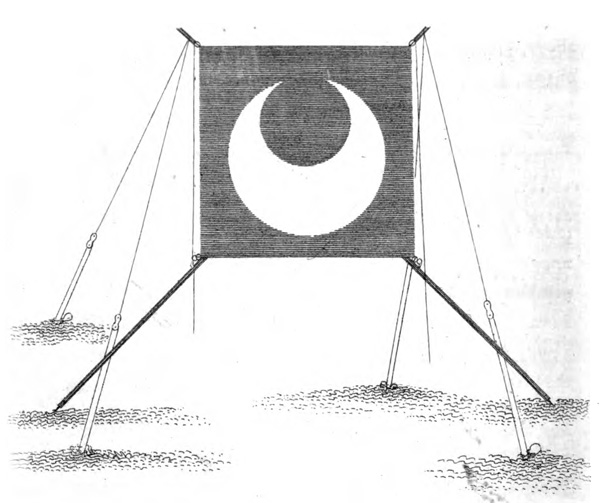
Portable Signal, detail (Plate 13?, facing p25), Conolly, A Treatise on Telegraphic Communication by Day and Night (1808)
Portable telegraphic machine pp 25-27 (includes a plate); On placing the machine pp 27-28; Table (color, Plate 17) showing 1-9, (n)o or Negative, Substitute or Interrogative, and Extra Substitute or Affirmative; examples of signals (plates 7, 8 and 9); Numerical signals p29; General remarks pp 30-33; Triangular Telegraph House for Night and Day, Plate 10; Triangular Telegraph House pp 33-35; Example of Three Projections, which express How, Are, You. (Plate 11); Numerical and alphabetical house signals, pp 35-36; Telegraph house pendants pp 36-38; Night Telegraph Table (Plate 12); On different codes, belonging to the House Telegraph p39; Night telegraph pp 39-41; Numerical & Alphabetical Fixed Telegraph (Plate 18); Alphabetical Table (Plate 14);
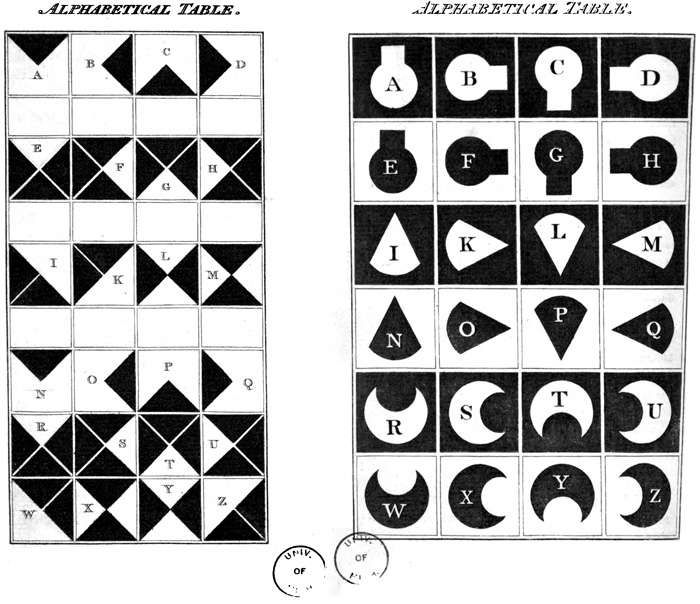
Alphabetical Tables (two plates, obscure number at left, plate 14 at right), Joseph Conolly, A Treatise on Telegraphic Communication by Day and Night (1808)
Numerical and Alphabetical Stationary Telegraph pp 41-43 (includes penned correction alphabetically to numerically
); Portable Night Alphabet (Plate 13) — rather like Braille, or dominoes; Portable Night Telegraph pp 43-44; On ships’ Night Signals p44; followed by Numerical Inflected Dictionary : 1 / Aback through 10935 / Zoology (totalling 174pp of numbered vocabulary/inflections (no phrases).
See also same author’s An Essay on Universal Telegraphic Communication (1817), which restates the alphabet, provides 72 phrases (in several languages), and dispenses with the inflected
vocabulary.
| 1817 | John Macdonald. A Treatise Explanatory of a New System of Naval, Military and Political Telegraphic Communication. | naval, military | Whitehall |
A Treatise Explanatory of a New System of Naval, Military and Political Telegraphic Communication
of General Application, in which a Comprehensive Numerical Dictionary...is applied...
By John Macdonald. T. Egerton’s, Military Library, Whitehall. 1817
original at NYPL.
As its title indicates, this volume contains two separate works, a treatise, and the dictionary. Each has its own title page —
Scire tuum nihil est, nisi te scire hoc, sciat alter. — Pers. Sat.
from Aulus Persius Flaccus (34-62), a Roman satirical poet and moralist, Satire I, line 26.
Usque adeone scire tuum nihil est, nisi te scire hoc sciat alter?
:
Is all your knowledge to go so utterly for nothing unless other people know that you possess it?
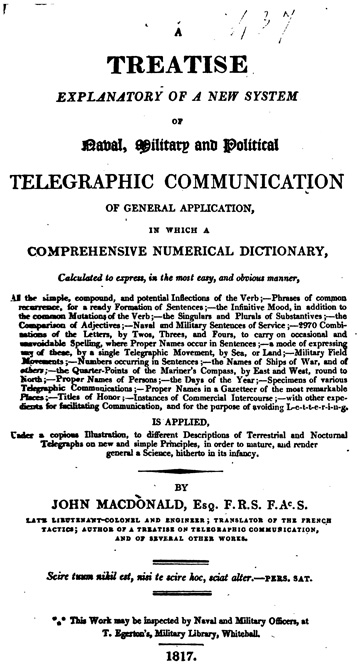 |
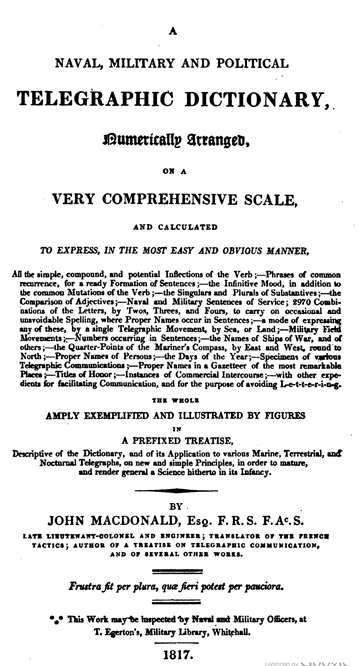 |
|
John Macdonald, A Treatise Explanatory... (1817) |
John Macdonald, A Naval, Military and Political Telegraphic Dictionary (1817) |
Macdonald’s systems were subject to criticism for being cumbersome; his anthropo-telegraph
involving five men holding flags, their actions guided by a sixth director
comes in for special derision by H. P. Mead in his The Story of the Semaphore
(Mariner's Mirror 19 (January 1933). See also David Lyndon Woods, The Evolution of Visual Signals on Land and Sea (dissertation, Ohio State University, 1976): 49. Macdonald’s signal system may have been flawed, but his vocabulary is quite interesting.
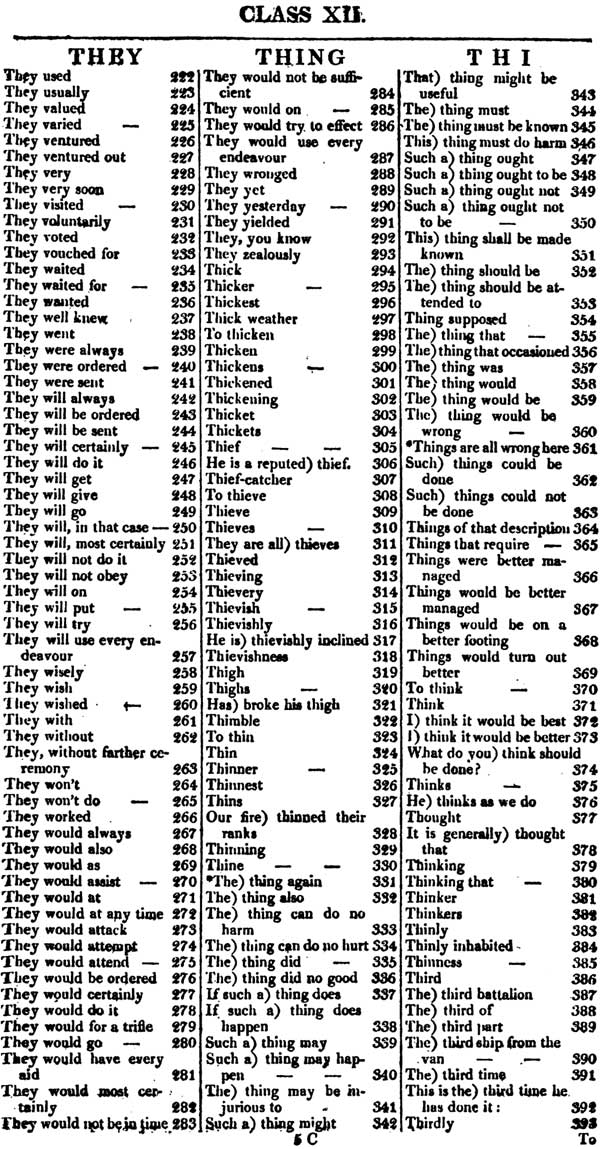
unnumbered page, Class XII
(then-thing-thirdly) ex John Macdonald, A Naval, Military and Political Telegraphic Dictionary (1817)
Macdonald arranges his vocabulary in 99 + 42 different classes (numbered 1-99, X-LII), each containing up to 999 instances (141 x 999 = 140,859 terms). The vocabulary contains single words, but many more phrases whose compilation he discusses in his introduction:
It appeared a defect of the two former Dictionaries [Macdonald’s own], that frequently occuring words, such as why, where, with, if, &c., &c. were not combined, so as to form adjunct current phrases. This has been effected in the instances of such words as are printed at the tops of the columns: and these various instances are, frequently, between two and three thousand. In doing this, it became necessary to compare such words with every word in a common Dictionary, selecting such combinations as struck the mind’s eye to be of common recurrence and use. This consideration alone will enable any person to judge of the labour it required to compose the Telegraphic Dictionary.
(p9, here)
Verbatim code?
Above, Class 22 : 998 / Had your suspicions — and many had
phrases preceding it, of all sorts. Presages so-called verbatim
codes, where verbatim
re-presentation of natural language is emphasized. But two objectives are at work here: (1) anticipation of any likely utterance in the phrase vocabulary as struck the mind’s eye to be of common recurrence and use,
and (2), the ability to reduce the number of signals needed for the transmission of a message, by increasing the size of the vocabulary. (I believe that Shannon talks about this.) In this code, Macdonald anticipates the verbatim codes, including Frederic G McCutcheon his enormous International Banking Corporation Telegraph Code / Phrase Tables of 1908.
I wonder if the scoliastic vocabulary — its exhaustive conjugations keyed to auxiliary verbs — like had,
have,
having
— was felt by some as either too exact or finely granulated in its phraseology, or wrongly favoring the auxiliaries over more appropriate headings, like 22:999 Had your supposition, where had your
might better have been located under supposition.
But the exhaustive phraseology looks forward to the statistical selection of phrase chunks extracted from a corpus, rather than to a logical classification scheme.
A more complete analysis of this remarkable code is in preparation.
| 1817 | Charles Lenox Sargent. A system of general signals for night and day | nautical | Boston |
A system of general signals for night and day
whereby merchant vessels may communicate at a distance by means of the common colours of the ship, and with four lanterns by night, without going out of their course
.
By Charles Lenox Sargent. Boston: Printed by Wells and Lilly, 1817.
original at Harvard Nav 578.17.2
circular signals (white and black, also semicircles), also flags and lanterns; some questions, names of places, compass directions, alphabet, description of vessel, &c., provisions, orders, &c. no long phrases.
First entries are questions — (1) Whence came you? (2) Where bound? (3) How long out? ... (16) Have you had soundings, where and how much? (17) Is it peace still? (18) Who are we at war with? (19) Any cruisers on the coast? (20) What coast is blockaded?
| 1817 | Joseph Conolly. An Essay on Universal Telegraphic Communication | general | Boston |
An Essay on Universal Telegraphic Communicationin which a plan is laid down for reciprocal intercourse between the different nations of the world in their respective languages; a principle the most simple and economical.
By Joseph Conolly, Telegraphist, author of the Telegraphic Dictionary, and other Vocabularies. London: Winchester & Son, Strand
original at Oxford University
Dedication (iii)-iv; Introduction (one page); two unnumbered (and possibly slipped in?) pages of phrases in Russian, 1-72; unnumbered page (loose?) of the Alphabetical and Numerical keys, bearing Bodleian size and shelflist no. 8o. B5.P.197
(?);
Alphabetical Table (Plate 5, facing p1); Universal Portable Telegraph, Explanation, pp1-5; — the entirety, including title page, repeated in French; — followed by Questions/Answers numbered 1-72, pp8-9;
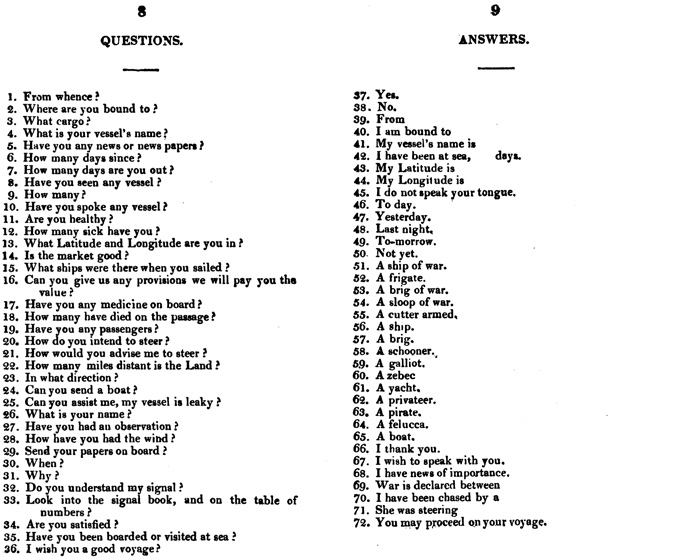
Joseph Conolly, An Essay on Universal Telegraphic Communication (1817), pp8-9 (reformatted)
Demands/Reponses (1-72), pp 10-11; Question/Respuesta (1-72), pp 12-13; Preguntas/Repostas (1-72), pp 14-15; Fragen/Antworten (1-72), pp 16-17; Vraggen/Antwoorden (1-72), pp 18-19; Svar/Fragor (1-72), pp 20-21; Sporsmaal/Svar (1-72), pp 22-23; Interrogazioni/Risposte (1-72), pp 24-25; followed by blank pages, numbered 1-36 verso 37-72 verso, pp 26-45.
Emphasizes the numeric over the alphabetical code; p2 of the Introduction explains use of a (white) answering symbol denoting the affirmative, and the checquered side of the same, [denoting] the negative answer, or no.
See also same author’s A Treatise on Telegraphic Communication by Day and Night (1808).
| 1818 | Thomas Lynn. An improved system of telegraphic communication. | general | Boston |
An improved system of telegraphic communication.Including a copious list of the names of places, persons, ships, articles in London price current, medicines, ship’s indent book, and an easy means of reference to Walker’s Critical Pronouncing Dictionary, whereby Every Word<.em> therein may be most easily signified, to the Exclusion of the tedious Operation of Spelling by Signal.
By Thomas Lynn. Second Edition (Carefully revised and further improved.) London 1818.
original at Bodleian 231.g.32
This book is interesting largely for the arrangement of its phrase matter. Lynn (1774-1847) was a commander of the East India Company and author of Nautical and Astronomical Tables (1825), Horary Tables for Finding Time by Inspection (1827) and other works, hints of which can be found in the contents of the telegraphic code described here. He was also one of the authors of An Historical and Descriptive Account of China (Edinburgh, 1836), his contribution being a chapter on navigation to China.
Lynn is briefly described at the online pages to The Skilfull Seaman, An exhibition of items from the Foyle Special Collections Library to mark the 200th anniversary of the Battle of Trafalgar (notes to Case 5). There is an entry on Lynn in the DNB.
BL has the earlier edition : An improved system of telegraphic communications. (Continuation of the general vocabulary. Supplementary vocabulary.), London 1814. Shelfmark 534.l.29.
The following list of contents is based on the Table of Contents found in the volume, which, however, does not accurately reflect what is in the book, whose pages have no folios.
- Instruction to the Second Edition.
The Introduction explains the incorporation of
Mr. Walker’s stereotyped
Critical Pronouncing Dictionary at pp xxvii-xxxi, starting here. The basic idea is to indicateWalker
with a D (forDictionary
) pennant, followed by indicators for page and word-number, respectively.The examples he shows do not exactly match page number, nor even location of folios, of editions available online, but this American edition published in 1818 serves well enough. Lynn’s usage of Walker is presented as a temporary expedient: he has been called to sea again, he writes, so that publication of his work in a complete state iincluding
a simple system of signifying all the words of the English Dictionary,
must await another time. (pp x and xxvii). - Two-Flag Index and Vocabulary.
promised in TOC, but does not appear in the volume. - Three-Flag Index and Vocabulary.
Single words, phrases, some instructions. Some surprising entries, too — for
dear,
forlove,
thoughtless,
turtle.
S83 Turtle. 1 -s. 2 a turtle feast, 3 I will send you some turtle, 4 have you any turtle? 5 I have turtle, 6 I have no turtle, 7 a good beach for turtle, 8 send on shore and endeavor to catch turtle, 9 I intend to try for turtle, 0 there is a fine turtle close to your ship apparently asleep on the water, S come and eat turtle with me!!!
- Vocabulary of the Names of Places, &c.
(Indicated by the Red Pennant.) - Vocabulary of the Names of Persons, &c.
(Indicated by the Blue Pennant.) - Vocabulary of the Names of Ships, &c.
(Indicated by the Blue Pennant.) - Blanks for Local Significations.
(Indicated by the Blue Pennant.) - Alphabet and Spelling Table.
(Indicated by the Yellow Pennant.) - Auxiliary Verbs.
(Indicated by the Yellow Pennant.)followed by main heading Miscellaneous Matter, beginning with
- Articles In Price Current.
(Indicated by the Yellow Pennant.)Terms used in Prices Current, &c.
- Ship’s Tradesmen, Stores, &c..
(Indicated by the Yellow Pennant.)This interesting list, grouped thematically, names the trades equipment pertaining to them. The larger categories are: Ship’s Stores, Boatswain’s Stores, Carpenter’s Stores, Coopers’s Stores and Tools, Gunner’s Stores, Cook’s Stores, Ship’s Steward’s Stores, Sails and Sail-Maker’s Stores, Captain’s Steward’s Stores, and Surgeon’s Stores,
The above followed by two additional sections, not included in Table of Contents —
Instructions relative to Sails.
Two pages of coded instructions, and two pages ofSails with their respective Primes
and
| 1828 | A New Code of Telegraphic Signals for Yachts and Pleasure Boats. | nautical | London |
A New Code of Telegraphic Signals for Yachts and Pleasure Boats
Richard B. Wynne. Edinburgh, Printed for the Author, 1828
original at Bodleian
unpaginated. includes these sections :
- Requisite Flags (pdf 11)
- Introduction (pdf 14-15)
- Local Table (pdf 16-21)
The following Seventeen Signals are made by hoisting the Substitute either over or under one of the flags. The Substitute is represented in the margin by the letter S.
The blanks may be filled up by such local significations or particular sentences as any two parties may previously agree upon.
This Table will be found particularly useful in communications between Steam Boats or other Vessels and their Agents on shore.[this page is lithographed ("Forrester lithog. Edin.r" shown at bottom); other pages showing penants are likely also lithographed.]
- Significations Denoted by the flags when hoisted singly; and alphabet instructions (pdf 22-24)
- Part I. Distinguishing Pendants of Particular Vessels and Signal Posts. Compass Signals. Alphabet. (pdf 26-29)
- Part II. Sentences. (pdf 30-61)
In the first ninety Signals of the following division of the Code, the Substitute is hoised over the Numeral Flags, and is represented in the marginal number by the letter S. - Part III. Flag 7, Preparative.
Numeral Table. Time Table. Persons’ Names. (pdf 62-76)
When any Signal is to be made from this division of the Code, First hoist the Numeral Flag 7, as a Preparative, and when that is answered, make the intended Signal. - Part IV. Flag 8, Preparative
Sea Port Towns, Islands, Headlands, &c. (pdf 78-95)
When any Signal is to be made from this division of the Code, first hoist the Numeral Flag 8, as a Preparative, and when that is answered, make the number of the intended Signal. - Part V. Vocabulary. (pdf 98-187)
Signals made from this Division of the Code, are distinguished by having Four FLAGS hoisted at a time. - Yachts’s Names (pdf 190-211)
| 1832 | The United States Telegraph Vocabulary, being an appendix to Elford’s Marine Telegraph Signal Book. | marine telegraph | Boston |
John R. Parker.
Boston: From the Steam Power Press Office. W. L. Lewis, Printer, 1832.
original at Harvard: Nav 578.32
| 1835 | The Universal Sea Language | naval, military | Whitehall |
The Universal Sea Language,
being a complete code of signals for day and night. Adapted to the use of vessels of all nations, and requiring no additional flags, or means, but such as are found in every vessel, even the smallest fishing craft... Published also in Danish, French, and German.
Levin Joergen Rohde
Translated from the Danish by Captain H. B. Dahlerup, R.D.N.
Second Edition. London, 1835
Bodleian 35.785
Front matter pagination starts at p vi (counting from title page) through xxviii, then code proper 1-175
Flags, phrases, compound
tables.
Rohde is mentioned in David Lyndon Woods his The evolution of Visual Signals on Land and Sea (Ohio State University dissertation, 1976), but only with regard to his night signals.
General Contents at p xiv :
| I | THE GREAT CODE OF SENTENCES, expressed by Pair Signals | xv | |
| PREPARATORY SIGNAL | xvii | ||
| Introduction | xviii | ||
| SIGNAL TABLE | xxii, xxiii | ||
| Explanation of the Code | xxv | ||
| Contents of each Chapter | xxviii | ||
| Communicating Sentences | 1 to 76 | ||
| COMPOUND TABLE | 79 to 123 | ||
| Alphabetical INDEX to Sentences | 171 to 174 | ||
| II | SELECTED SIGNALS, being certain Signals set apart for some of the most important sentences, required to be communicated with as little loss of time as possible | 125 | |
| III | THE LESSER CODE OF SENTENCES, expressed by Pair Signals, for the use of vessels not provided with the number of flags required for using the greater Code | 127 | |
| Introductory Remarks | 128 | ||
| SIGNAL TABLE | 130, 131 | ||
| Contents of each Chapter | 134 | ||
| Communicating Sentences | 135 | ||
| COMPOUND TABLE | 147 | ||
| IV | SIGNALS to be used by PILOTS to vessels in distress, when it blows so hard that they cannot be boarded | 152 | |
| V | SIGNALS to be used by Vessels having lost their Masts, or for Wrecks | 158 | |
| VI | NIGHT SIGNALS | 163 | |
Shown below are the underlying flag signals for s-p-e-l-l-i-n-g and for Great and Lesser code vocabularies. The elementary signals run 1-40. —
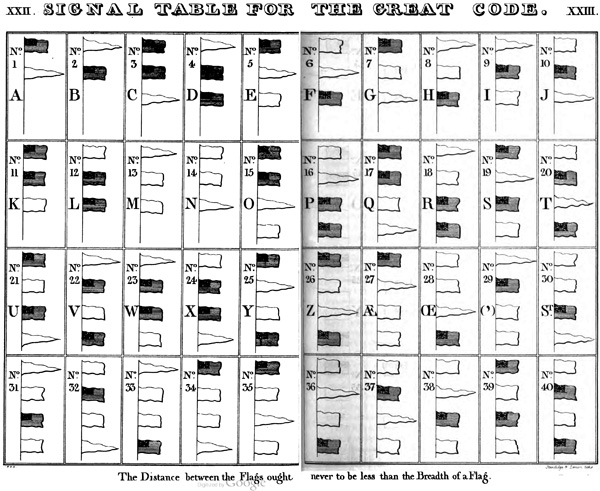
ex Levin Joergen Rohde, The Universal Sea Language, London, 1835; pp xxii-xxiii, from google scan
Here are sentences taken from Chapter 12 in the Great Code of Sentences,
with indications for use of the Compound Table, including one instance (1245) with two usages within one sentence. A page from the Compound Table is shown immediately following these sentences. —
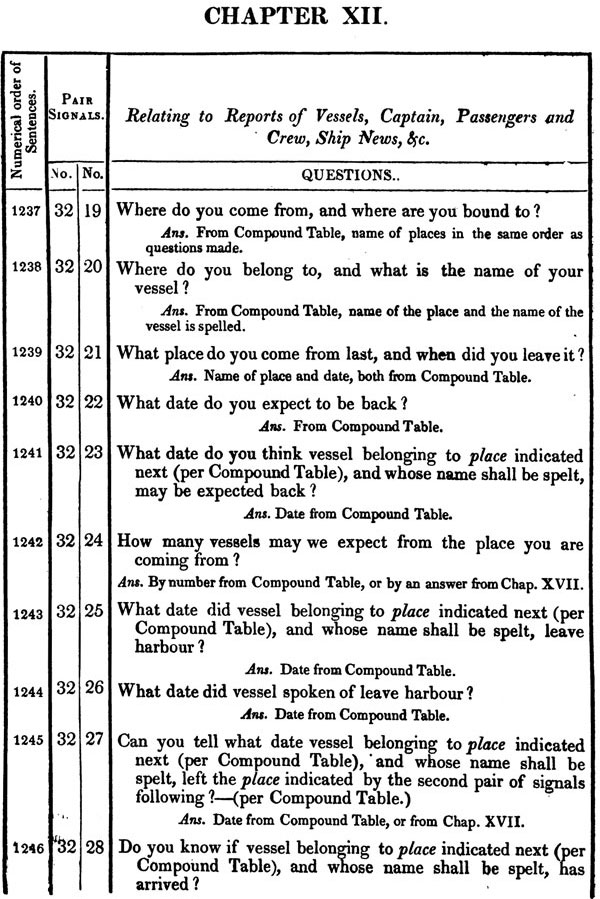
ex Levin Joergen Rohde, The Universal Sea Language, London, 1835; pp 60, from google scan
The correct meaning of the signals taken from the Compound Table will always be given in the sentence that precedes it. Some later telegraphic codes employed variations of this technique. Here is the salient passage from the Directions,
which also provide examples. —
This Table is composed of such objects of inquiry and conversation at sea, as generally require to be formed into so many different tables, with each its proper distinguishing signal; such as points of compass, date of the month, day of the week, hour of the day, degrees of latitude and longitude, names of harbours, towns, headlands, &c. The bringing of this heterogeneous matter together into one table, is founded upon the supposition, that a preceding sentence clearly shows the column of the Compound Table to which the signal made refers, or in which the answer to be given must be sought for. And though the signals for this table are the same which are used to express sentences, yet no mistake can happen, as it will always be clear from a preceding signal, whether the signal following, or the answer required, is to be looked for in the Compound Table, or not.
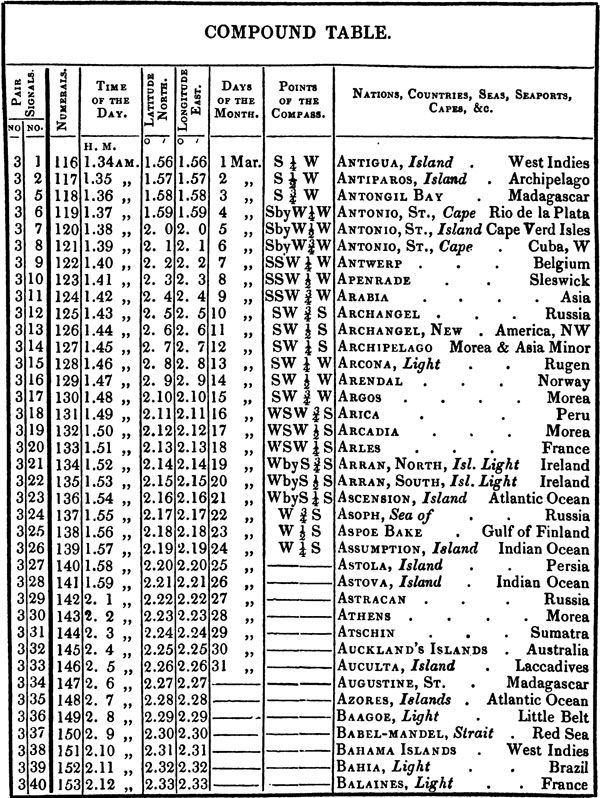
ex Levin Joergen Rohde, The Universal Sea Language, London, 1835
Here are sentences taken from Chapter 15 in the Great Code of Sentences
—

ex Levin Joergen Rohde, The Universal Sea Language, London, 1835; pp 70, from google scan
The phrase vocabulary in Rohde is rich and interesting (e.g., the sentences regarding piracy); see also pp 125-26 for SELECTED SIGNALS, being certain Signals set apart for some of the most important sentences, required to be communicated with as little loss of time as possible.
| 1835 | H. Cranmer Phillipps. A Code of Universal Naval Signals | marine telegraph | London |
A Code of Universal Naval Signals
A Code of Universal Naval Signals, Calculated to afford the means of Communication between Ships of All Nations; and arranged so as to be easily translated into foreign languages: in which are included Night Signals, a plan for boat signals and for a semaphore or telegraph; together with a cypher for secret correspondence.
H. Cranmer Phillipps, R.N. London: 1835
on cover : London: Longman, Rees, Orme, Brown, Green, & Longman, Paternoster Row; and G. Tremlett, Bristol, MDCCCXXXV.
original at Bodleian (35.777)
employs five flags — pendant, National Jack, guidon, cornette, two balls, vane and wheft.
The Flags or Symbols used in the following Signals (Plate 1); examples (Plate 2); Size of the Flags; Alphabetical Index of Sentences (xiii-xviii); Sentences (1-17); Auxiliary Words (18-21); Compass Signals and Bearings (22); Alphabet (23); Numeral Signals (24-25); Vocabulary (explanation pp 26-28; 29-54); Alphabetical Index to Vocabulary (55-102); Geographical Table I (103-116); Geographical Table II (117-127); Geographical Table III (128-132); Night Signals (133-137); Fog Signals (138-139); Signals with Bells (139-140); Convoy Signals (141-142); Private Signals and Cypher (143 — merely by altering the order of numbers in Plate I
); Distant Signals (146); Semaphore & Manual Telegraph (147-148, plus Plate 3); Boat Signals (149-150); Local and Pilot Signals (151); Shipping List (158)
The sentences are arranged thematically and, as is the case with the first part of other signal codes, are devoted to distress, navigational, security and other critical communications. The explanation of the vocabulary
cautions against its use by foreigners without acquaintance with the language.
| 1836 | The New Semaphoric Signal Book, in Three Parts | marine telegraph | Boston |
The New Semaphoric Signal Book, in Three Parts
containing the Marine Telegraph System, with the Appendix, The United States Telegraphic Vocabulary and embracing the Holyhead Signals, to which is annexed The Boston Harbor Signal Book.
John R. Parker. Boston: Printed by Light and Stearns, 1836.
original at Harvard: Nav 578.36
| 1845 | The Telegraph Dictionary and Seamen’s Signal Book | marine telegraph | Boston |
The Telegraph Dictionary and Seamen’s Signal Book
adapted to signals by flags or other semaphores; and arranged for Secret Correspondence, through Morse’s Electro-Magnetic Telegraph: for the use of Commanders of Vessels, Merchants, &c.
Henry J. Rogers. Baltimore: Published by F. Lucas, Jr., 1845.
original at Harvard: Nav 573.45.3
| 1847 | A Code of Signals for the use of vessels employed in the Merchant Service | merchant service | London |
by Captain Marryat, R.N.. Tenth Edition, entirely revised and corrected.
London. J. M. Richardson, 23, Cornhill., 1847.
original at Bodleian : 47.312
| 1848 | Signal Book for Boston Harbor | marine telegraph | Boston |
by Hudson & Smith. Offices; Observatory, Central Wharf, and Old State House.
Boston: 1848. Eastburn’s Press.
original at NYPL
pp6-14 phrases; pp 15-77 are telegraphic register (mostly blank in the earlier pages) of vessel names.
| 1851 | A Code of Signals For the use of vessels employed in the Merchant Service. | merchant service | London |
(Eleventh Edition, entirely revised and corrected)
Captain Marryat, R.N. London: J. M. Richardson, 1851
original at Bodleian (231.h.11)
Dedicated to The Committee of the Society of Ship-Owners of the Port of London.
Note to the Eleventh Edition :
With the view of rendering this Code of Signals as complete and as perfect as possible, there has been added to the present Edition a plate of the Mercantile Flags of those nations whose Merchant Vessels are more frequently met with at sea; the list of Lighthouses has not only been much enlarged in number, but for the first time it has been rendered still more serviceable by the addition of the description of light, whether fixed or revolving, its latitude and longitude, and the number of miles at which it is visible; and to afford greater facility in reference, the Sentences have been further extended by reduplication.
| 1854 | Universal Code of Signals | merchant service | London |
Universal Code of Signals For The Merchant Marine of All Nations, by the late Captain Marryat, R.N., with a selection of sentences adapted for convoys, and systems of geometrical signals.
Twelfth Edition.
By G. B. Richardson. London: J. M. Richardson, 1854
original at Bodleian (231.h.12)
Successive editions of Marryat introduce changes. This introduces a second distinguishing pendant,
to accommodate the increased number of Merchant Vessels requiring distinguishing numbers.
| 1857 | Code international: Télégraphie nautique (quatrième edition) | nautical | Paris |
Nautique réglemantaire pour les bâtiments de guerre et de commerce Français, acceptée par les gouvernements d’Angleterre, des Pays-Bas, de Sardaigne, de Suède / de Grèce, de Naples, de Belgique, de Prusse, de Novége, de Russie, de l’Uruguay, de Hambourg / d’Oldenbourg, du Chile, de Danemark, d’Autriche, etc., etc. publiée sous les auspices et par les ordres de S. Exc. M. Le Ministre de la Marine et des Colonies / par Charles de Reynold de Chauvancy... Quatrième Édition
Paris: Librairie de L. Hachette et Cie, 1857
original at Stanford
| 1855 | Reynold’s Code. Polyglot Nautical Telegraph for the use of men of war and merchant vessels. | nautical | London |
Charles de Reynold-Chauvancy; revised by F. H. Simpkinson. London, 1855
title page missing in scan; original at Bodleian
Observations on the use of the repertory. (xxii)
The subjoined repertory has no pretensions to be a complete dictionary of marine terms and geography; its size is too restricted. The object that the Author has had in view, and which he hopes to have attained, is to give to the Marine Telegraph Code greater extension, by suppressing all causes for slowness and errors, by the addition of numerous phrases, and the suppression of divisions and chapters or series, and to make a vocabulary applicable equally to ships of war and merchantmen...
This work, which will appear shortly translated into various languages, with great care, cannot fail to become general under the protection of the respective Governments; it will permit all vessels to converse as easily as if all the sailors in the world spoke but one uniform language.
note — In 1855-56, the Board of Trade examined 13 codes of signals that had been published between 1808 and 1856, and made recommendations based on that study. In 1857, there was published The Commercial Code of Signals, for the Use of all nations, compiled by John T. Forster and based on those recommendations.
| 1858 | Ward’s Code of Signal Telegraph, for Ocean Marine Service, alphabetically arranged | nautical | Auburn, N.Y. |
with all the principal seaport towns, light-houses and islands in the world, with their latitudes and longitudes, including North American Lake and River Navigation.
William Henry Ward, inventory of the Marine Telegraph,patented bullet-and-shell moulding machine, turn-tables, etc.
Auburn, N.Y.: Published by the Author, 1858
original at NYPL
System and mechanism, no vocabulary. Twelve (12) pages only — introductory material — of a volume whose table of contents covers pp 14-287. See entry for Ward’s The Ocean Marine Telegraph (1861).
| 1861 | Second Edition of Ward’s Ocean Marine Telegraph, Illustrated. | marine telegraph | London |
Second Edition of Ward’s Ocean Marine Telegraph, Illustrated.
By William Henry Ward, 7, Sackville Street, Piccadilly. London: Published by the Author, January 1861
original at Bodleian (231.e.46)
pp5-8 Instructions for using the "Lights" for Night Signals
This system is so well adapted for spelling, that good operators would prefer it to code-books for maintaining continuous communications.
The following Tables will serve to illustrate the indications, without reference to the Plates — and should be committed to memory...
followed by pages (including unscanned plates) on the fog signals and their use.
followed by title page reading :
Seventh Edition of Ward’s International Prize-Medal Signal Telegraph. Illustrated. / London: W. H. Ward, 24, Union Square, N., and Auburn, New York, United States... 1863), followed by plates 1-3 of Ward’s Night Signals (employing 7 lantern positions), followed by pages devoted to Ward’s Bullet Machine, Shell Moulding Machine, and Self-Centering Railway Turn-Table.
| 1864 | Universal Code of Signals. | marine telegraph | London | archive.org |
Universal Code of Signals
For The Merchant Marine of All Nations, by the late Captain Marryat, R.N., with a selection of sentences adapted for convoys, and systems of geometrical, night, & fog signals.
By G. B. Richardson. London: Richardson & Compy., 1864
original at Bodleian
was at Google Books, now archive.org.
The Code consists of Six Parts:— 1. A list of English Men of War. 2. A List of Foreign Men of War. 3. A List of Merchant Ships of all Nations. 4. A List of Lighthouses, Ports, Headlands, Rocks, Shoals, Reefs, &c. 5. A Collection of Sentences. 6. The Vocabulary.
| 1866 | Universal Code of Signals. | marine telegraph | London |
Universal Code of Signals
For The Merchant Marine of All Nations, by the late Captain Marryat, R.N., with a selection of sentences adapted for convoys, and systems of geometrical, night, & fog signals.
By G. B. Richardson. London: Richardson & Compy., 1866
original at Bodleian (231.h.7)
| 1866 | Code Universel de Signaux. | marine telegraph | London |
Code Universel de Signaux
Code Universel de Signaux. À l’usage Des Navires du Commerce de Toutes les Nations, de Frederic Marryat, Capitaine de Vaisseau de la Marine Anglaise; aven une Liste de Yachts, et un Recueil de Phrases à L’Usage des Convois, et des systèmes de Signaux Geometriques, de Nuit, et de Brume.
Par G. B. Richardson. London: Richardson & Cie., 1866
original at Bodleian (231.h.8)
| 1866 | International Day, Night, and Fog Signal Telegraph. | marine telegraph | London |
International Day, Night, and Fog Signal Telegraph
(first edition — although Google Books overview
identifies it as 2nd edition)
With all the chief sea port towns, places, islands, seas, and rivers of the world, alphabetically abbreviated in dictionary order, likewise many useful nautical sentences, etc.
William Henry Ward. London: 75, Hatton Garden, 1866
original at Bodleian (231.h.4)
general abbreviations
pp 19-34, including these —
B,O,S, — Boston, Mas. U.S.
B,O,U, — Boulogne, France.
B,P, — Be Punctual.
B,Q, — Be Quiet.
B,Q,I, — Be Quick.
B,R, — British.
B,R,&, — British and Irish Steam Packet Company’s Steamer No. ——
B,R,A, — Brazil.
B,R,E, — Bremen, Holland.
B,R,G, — Brig.
B,R,I, — Bristol, England.
B,R,K, — Broke.
B,R,O, — Broken.
B,R,T, — Brest, France.
B,S, — Be Steady.
B,T, — Be Taken.
B,U. — Be Urgent.
B,U,A, — Buenos Ayres, S.A.
B,U,O, — Buoy.
B,U,O,A, — Buoy, or otherwise mark the place.
The system is a kind of stenographic shorthand, whose abbreviations are comparable to the telegraph code, or to mnemonic systems.
pp 35-36 discuss the system of which which the book is a part, along with signal flags, lantern, etc.
...But do not allow yourself to be perusaded that eighty shillings—equal to one hundred francs or twenty dollars—is the price for this little book, as a book. Not so, the price affixed is for the system. The book,
as a book,
is not considered, and will not be in the book trade as a book
only to be had of the author, who will affix the number and his signature to the bottom of the TABLE, which will be authority for the holder or purchaser thereof, to use book and SYSTEM.
The producer of the foregoing is the author of a work on THEOLOGY, entitled
THE TREE OF LIFE IN THE PARADISE OF GOD.
It being a key to the deep things of the Bible, corresponding with the foregoing on signal telegraphy; and is worthy the attention of all who love their bibles...
Ward is further described as the inventor and/or patentee of a self regulating bomb-shell fuze,
a bullet compressing machine,
and the cheapest, and easiest turning Railway Turn Table heretofore offered...
For further information, or for any of the foregoing articles—please communicate with their author, W. H. Ward, 75, Hatton Harden, LONDON, whose terms are exclusively CASH.
| 1866 | William Henry Ward. International Day, Night, and Fog Signal Telegraph (second edition) | marine telegraph | London |
International Day, Night, and Fog Signal Telegraph (second edition)
Second Edition of the International Day, Night, and Fog Signal Telegraph, with all the chief sea port towns, places, islands, seas, and rivers of the world, alphabetically abbreviated in dictionary order, likewise many useful nautical sentences, etc.
London: 75, Hatton Garden, 1866
original at Bodleian (231.h.5)
32 pages, most given to promotional language and instructions in use; the abbreviations
are in pp 17-32.
With reference to things in general, and new in particular,— first, Is it good?—Second, Will it advantage matters to use it—Third, If used—will it pay?—To all these questions this new system answers YES—at a much less cost in addition—as by it all signal flags and codes are dispensed with. Do you enquire how? The answer will be found by a careful perusal of what follows...
| 1869 | Universal Code of Signals | marine telegraph | London |
Universal Code of Signals
For The Mercantile Marine of All Nations, by the late Captain Marryat, R.N., with a list of yachts, and a selection of sentences adapted for convoys, and systems of geometrical, night, & fog signals.
By G. B. Richardson. London: Richardson & Compy., 1869
>original at Bodleian (231.h.10)
introduces a fourth distinguishing pendant,
and a correct List of Yachts; other changes include additional words and sentences inserted in Part V.
9 September 2012